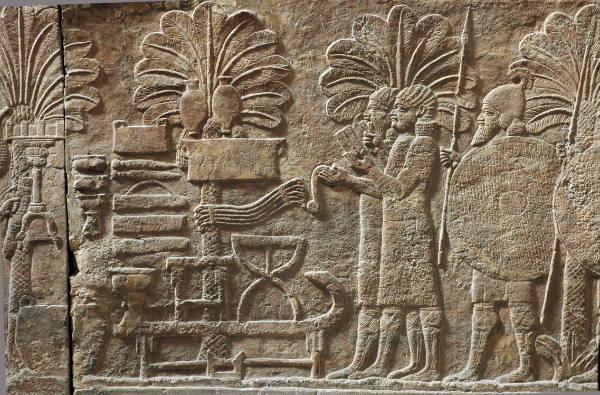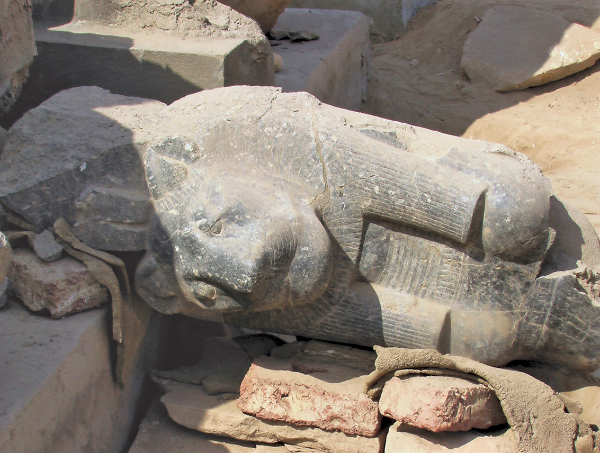Habakkuk’s Second Complaint and the Lord’s Answer (1:12–17)
Rock (1:12). Among the titles given to Yahweh are “Holy One,” “my fortress,” and “Rock” (see Deut. 32:15; 1 Sam. 2:2; Ps. 18:2–4). The reciting of these titles as a litany of thanks is usually part of an acknowledgment of God’s saving acts (see Isa. 17:10). Habakkuk draws on this tradition of Yahweh, the creator or “shaper” of life, in expectation that what he has heard about Yahweh will ultimately set aside any thought that God has brought on the destruction of Judah by her enemies.27 The use of this title as an attribute of deity is found in personal names both in the Bible (Elizur, Num 1:5; “my God is a Rock”), as well as in Amorite personal names in the Mari texts (such as Ṣuri-Dagan).28
Hooks … net … dragnet (1:15–16). Nineteenth-century B.C. Egyptian wall paintings from Beni Hasan depict fishermen using spears, hook and line, as well as dragnets made of woven baskets (see Ezek. 12:13; Amos 4:2).29 Rulers, in their propagandistic pronouncements, used proverbs or metaphors to depict their strength. Thus they were capable of trapping their enemies like fish or birds in a net (see Hos. 5:1). For example, the use of a net filled with fish is found in the account of Pharaoh Thutmose III’s victory at Megiddo, where he refers to his enemies “lying prostrate like fishes in the bulge of a net.”30 In the Mari texts, the gods assist the king to overcome treacherous enemies, promising to gather Babylon “into the net” and assuring him that the ruler of Eshnunna will be collected “into a net with which I will surround him.”31

Relief at Edfu with king netting wild animals as well as enemies
Lenka Peacock
The Lord’s Answer (2:2–20)
Write down the revelation (2:2). Like Isaiah (Isa. 30:8), Habakkuk is commanded to write down his oracle. The Hebrew in this phrase suggests a double meaning of a clearly written message, on stone or wood, as well as one that should be transmitted and acted on quickly. Roberts, drawing a parallel with Proverbs 18:10, even suggests that the words of the Lord could serve as a refuge, “a tower,” once they are delivered.32 Professional messengers, who carried tablets that contained situational updates, diplomatic correspondence, and provincial requests, were an important component of both everyday business and of the critical aspects of diplomacy in the royal courts the ancient Near East.33 They were needed as “runners” to carry their lord’s commands since kings seldom paid state visits to each other’s capitals (see Baruch’s mission in Jer. 36:4). Naturally, the content of the message that they transported as swiftly as possible could bring relief or concern, and the free flow of information or military intelligence could be forestalled by a city ruler who, for his own purposes, chose to detain the messenger.34
Piles up stolen goods (2:6). Habakkuk warns the plundering Babylonian armies that though they have enriched themselves with the goods they have stolen from the people of Judah, there will come a reckoning when the “debtor” nations will derive revenge on the “creditor,” with Babylon in turn left as a plundered shell.35 Such a reversal of fortunes is also found in Amos 4:1–3, where the gluttonous “cows of Bashan,” who cried out for more while the people starved, eventually are cast out of their looted houses and left unburied like some refuge on a dung heap.

Pile of goods plundered from city
Z. Radovan/www.BibleLandPictures.com
It may be that Habakkuk is also drawing on the social injustice theme, charging the leaders with abusing the laws that require day laborers and the destitute to hand over their cloaks in pledge that they will complete their assigned tasks (Ex. 22:26–27; Amos 2:8). The Yavne-Yam inscription contains a claim by a man who asks that his garment, his only possession, which had been given in pledge, be returned and his honor restored as a free man.36
Lebanon (2:17). The forests of Lebanon are mentioned in the earliest texts from Mesopotamia. Each strong ruler began his royal annals and his career by staging campaigns to establish ownership over the cedar needed to help construct their palaces and temples. The Assyrian king Tiglath-Pileser I (1114–1076) notes in his annals: “Upon the command of Anu and Adad, the great gods, my lords, I went to the Lebanon mountains. I cut cedar beams for the temple of Anu and Adad.”37
According to his royal annals, Nebuchadnezzar ordered his army to construct a road “for the transport of the cedars” of Lebanon. He describes how they “cut through steep mountains, split rocks, [and] opened passages” to build this commercial logging road.38 This was done in the name of freeing the land of its foreign enemies. However, these trees actually were used to build his palace and to enhance the temple of Marduk in Babylon.
Image that teaches lies (2:18). As Jeremiah says (Jer. 2:11), idols are not gods but are only items shaped by human hands and treated as objects of worship (cf. Isa. 46:7; Hos. 4:12; 14:4). Clearly, the texts from ancient Mesopotamia assert that the gods are present in their statues.39 Some may have chosen to support Nebuchadnezzar’s control of Judah by pointing to his piety and devotion to the gods of Mesopotamia.40 Thus, the prophet’s use of the phrase môreh šāqer (lit., “teacher of lies”) is a polemic against such belief, and this represents Habakkuk‘s charge that priests and kings manipulate people by “making idols that cannot speak” or pronounce an oracle in the name of the god. His reference to gods that cannot speak may be part of his own concern over Yahweh’s silence at that time.41
Lifeless stone (2:19). The archives of the Assyrian king Esarhaddon contain a text dealing with the theological problem of crafting a divine image. The king asks: “Whose right is it … to create gods and goddesses…. Is it the right of deaf and blind human beings who are ignorant of themselves?” He then calls on the gods to send an omen to indicate when and how these images are to be created and to endow the craftsmen with divine knowledge and skill.42

Head of the goddess Mut lying broken on ground at the location of her temple
Manfred Näder, Gabana Studios, Germany
Once an image was shaped, the rituals of mouth-washing and “opening the mouth” were initiated in Babylon to transform a fabricated object into the physical embodiment of the god. Both rituals were predicated on the belief in a divine collaboration between the gods and the craftsmen to create through “inspirational co-operation” a divine statue.43 The “Opening of the Mouth” ritual also purified the image and restored its sanctity after coming into contact with impurity or an improper ritual act.44